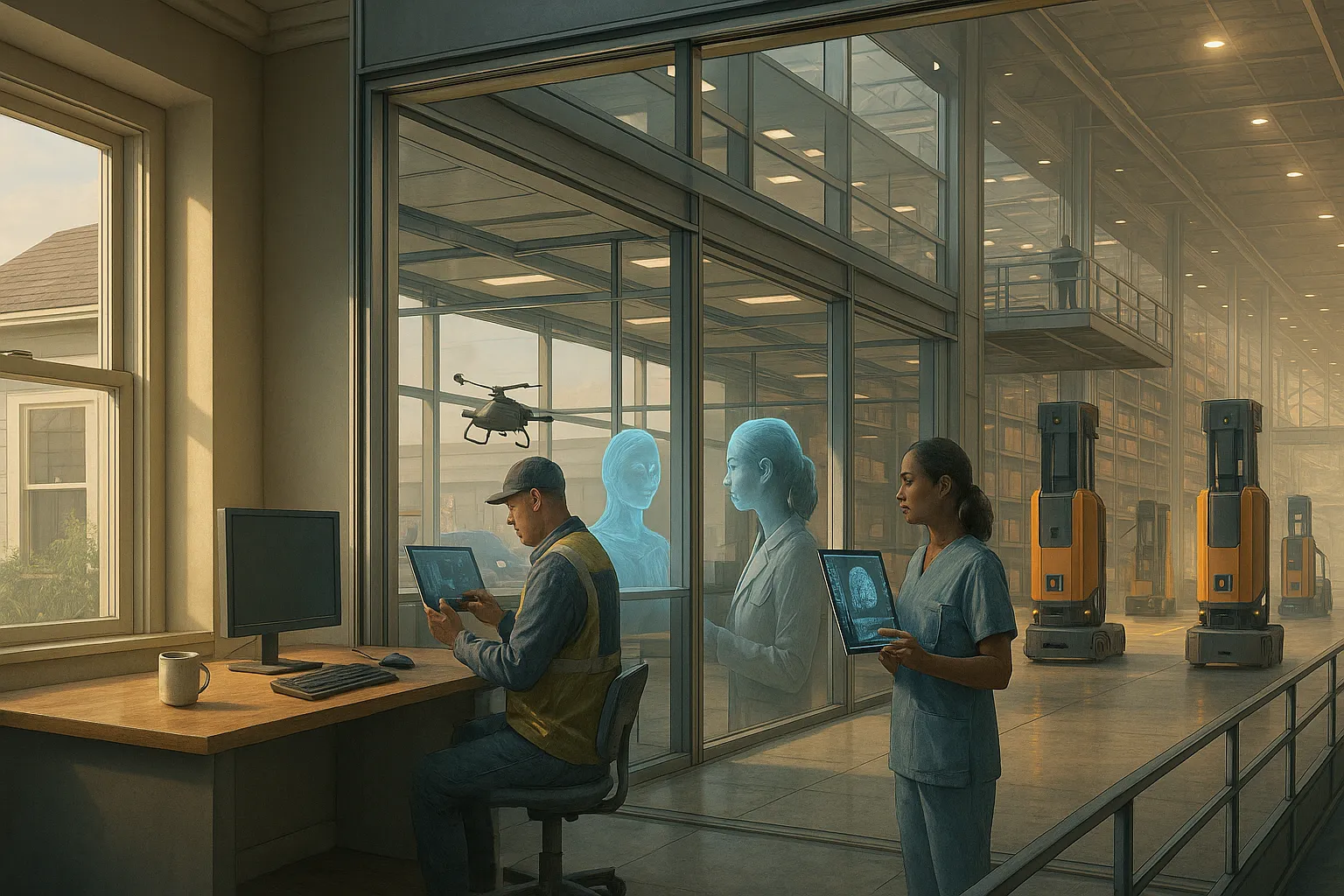💡 TL;DR - The 30 Seconds Version
💥 AI wiped out 14% of American jobs but will create 6.7 million new ones by 2033—prompt engineers now make up to $270,000 a year
🏭 Amazon's robot warehouses cut staff by 25% while Microsoft fired 6,000 people in 2025, mostly software engineers
🏥 Radiologists grew 55% after experts said they'd vanish—two-thirds of departments use AI as helpers, not replacements
🎬 Hollywood writers won the first AI work rules in 2023, banning studios from using machines to write scripts
🌏 Europe protects workers with tough AI laws; Asia uses robots to fix aging workforce; America lets markets sort it out
🚀 Workers who know AI earn 25% more as 39% of job skills must change by 2030—learn fast or fall behind
The robots aren't just coming for factory workers anymore. They're writing marketing copy, reviewing legal contracts, and answering customer service calls. Eric Fein's story shows how fast the shift can happen. After a decade building his content-writing business in suburban Chicago, charging $60 an hour to craft everything from cannabis company websites to bath mat descriptions, his entire client base vanished in March 2023. The culprit? ChatGPT.
His experience captures a larger truth emerging from the latest employment data: artificial intelligence is reshaping American work in ways that defy simple narratives about job-killing robots.
The numbers tell a nuanced story. While 14% of American workers have already experienced job displacement due to AI and automation, the Bureau of Labor Statistics projects 6.7 million new jobs will emerge by 2033. The technology that eliminated writing careers is simultaneously creating positions for prompt engineers earning up to $270,000 annually.
This transformation extends far beyond Silicon Valley cubicles. In warehouses from Spokane to Detroit, 750,000 Amazon robots work alongside humans who've moved into 700 job categories that didn't exist before automation arrived. On farms across California's Central Valley, precision agriculture systems that reduce herbicide use by 94% are creating demand for drone operators and data analysts while displacing field workers. The pattern repeats across industries: displacement in some areas, expansion in others, and wholesale transformation nearly everywhere.
The Automation Equation Gets Complex
Traditional economic models suggested a straightforward trade-off: machines replace workers, productivity rises, prices fall, demand increases, employment rebounds. Today's AI revolution scrambles that formula. Unlike previous waves of automation that primarily affected manual labor, artificial intelligence targets cognitive work—the supposed safe haven for displaced factory workers.
The technology now threatens white-collar professionals who spent years believing their college degrees provided protection from technological unemployment. Goldman Sachs estimates 300 million full-time jobs globally face exposure to AI, with two-thirds of U.S. occupations potentially affected.
The impact varies dramatically by role. GitHub's AI coding assistant helped developers complete tasks 55% faster in controlled studies, with junior programmers seeing the biggest gains. One Microsoft study found developers using AI produced 26% more output weekly. Yet this same productivity boost enabled Microsoft to lay off 6,000 employees in early 2025—roughly 3% of its workforce—with 40% of cuts hitting software engineers.
Programming sits at the forefront of AI integration, making engineers among the first to feel the impact. They won't be the last, according to researchers at the Brookings Institution.
Healthcare's AI Paradox
Medicine offers a counterintuitive lesson about AI and employment. In 2017, prominent technologists predicted radiologists would soon be obsolete. Instead, the field has grown 55% as AI became a powerful diagnostic assistant rather than replacement.
AI now runs in two-thirds of radiology departments, twice as many as in 2019. The software spots tumors, strokes, and fractures in medical scans, flagging the worst cases first. When Neuroradiology tested these tools, they caught brain bleeds fast enough to save lives.
The technology elevates average practitioners to expert performance levels—patients win, and radiologists keep their jobs while handling more complex cases. Stanford research confirms that humans plus machines outperform either working alone.
Similar patterns emerge across healthcare. AI "medical scribes" now transcribe patient visits, reducing documentation hours. Major health systems report physicians using these tools experience lower burnout and spend more time with patients. The technology handles drudgery while humans provide empathy and judgment.
Education Adapts to the ChatGPT Era
Few professions faced as jarring a transition as teaching when ChatGPT arrived. Within months of its November 2022 launch, one in four teachers caught students using AI to cheat. School districts rushed to ban the chatbot, fearing an academic integrity crisis.
Yet by the 2023-24 school year, 60% of teachers had integrated AI into lessons, up from 40% the prior year. The panic gave way to pragmatism.
Teachers now use ChatGPT to generate creative project ideas—like having students design alien planet posters for science fiction units. The technology can rewrite complex texts at lower reading levels for struggling students or translate materials instantly. It handles vocabulary quizzes and practice problems while teachers concentrate on instruction and mentoring.
Professional development expanded rapidly, with 43% of teachers receiving AI training by 2024. Districts crafted acceptable use policies. Rather than replacing teachers, AI became another tool—like calculators or spell-check—useful when applied properly but no substitute for human guidance.
Wall Street's Digital Workforce
Financial services faces the steepest automation cliff. Citigroup research indicates 54% of banking jobs have high automation potential. Already, AI handles millions of customer interactions, processes loan applications, and flags suspicious transactions.
JPMorgan Chase exemplifies the sector's transformation. The bank employs over 2,000 AI specialists working on 400 applications. More than half its employees use AI tools daily, generating $1.5 billion in fraud prevention and operational savings. Yet rather than mass layoffs, JPMorgan continues hiring—for different roles.
AI compliance officers, algorithm auditors, and machine learning engineers command 25% wage premiums over traditional banking positions. The legal profession shows similar patterns: while Goldman Sachs projects 44% of legal work could be automated, paralegal positions still show 4% projected growth through 2032. Why? LexisNexis's AI shows 17% error rates in legal research. Human oversight remains essential.
Even customer service, ground zero for automation, reveals complexity. MIT research shows AI tools help new support staff match experienced colleagues' performance much faster. Companies handle more volume without adding headcount. But purely automated systems often fail spectacularly—customers still demand human options for complex issues.
Hollywood Fights Back
Creative industries mounted the strongest resistance to AI encroachment. When ChatGPT demonstrated script-writing capabilities, Hollywood writers saw an existential threat. The Writers Guild of America's 2023 strike secured unprecedented protections. Studios agreed AI cannot write or rewrite scripts, writers can't be forced to adapt AI-generated material, and any AI involvement must be disclosed.
"For the first time, we have put enforceable limits on the use of AI," said WGA negotiator John August, according to reporting by The Hollywood Reporter.
Visual artists launched parallel battles. Class-action lawsuits against Stable Diffusion and Midjourney allege these companies trained AI on millions of copyrighted images without permission. Voice actors worry about AI clones. Musicians fear algorithmic composers. The creative sector's message: AI can assist human creativity but shouldn't steal work or replace artistic vision.
The Warehouse Revolution
Amazon's fulfillment centers showcase automation's double edge. The company deployed 750,000 robots while maintaining over 1.5 million employees. For years, robots simply assisted workers. That's changing.
Amazon's newest facilities process orders 25% faster at 25% lower cost than older centers. From 2022 to 2024, package volume rose 20% in traditional delivery hubs, matched by 20% staff increases. But in automated fulfillment centers, employee numbers fell 10% despite growing order volumes.
One analysis found roughly 25% reduction in expected fulfillment center staffing due to recent automation gains. Internal documents obtained by Business Insider indicate robots will "flatten Amazon's hiring curve" as the company fulfills more orders with fewer workers.
Similar dynamics play out across logistics. Autonomous trucks pilot programs expand in Texas and Arizona. By early 2025, companies like Aurora and Kodiak Robotics plan completely driverless big rigs on select highways. For America's 3.5 million truck drivers, the implications are stark.
The Teamsters union lobbies for laws requiring human operators, with limited success. While a Department of Transportation study suggests only 11,000 driving jobs might disappear over five years, many drivers see that as just the beginning.
Global Perspectives: Different Approaches, Similar Challenges
The AI workplace revolution plays out differently across regions, shaped by culture, regulation, and economic priorities.
Europe: Caution and Protection
European adoption lags the United States, with about 25% of workers using AI tools versus higher American rates. Stronger labor protections and union influence slow aggressive automation. The EU's comprehensive AI Act emphasizes transparency, privacy, and "human-in-command" requirements.
European officials stress "AI augmentation" over replacement. Germany's engineering sector embraces AI for design and maintenance while retraining displaced workers. Surveys show European employers expect job reductions in administration and services but at a "manageably low" pace. The cultural emphasis: make AI work for workers by eliminating dangerous tasks while preserving employment.
Asia: Embracing Necessity
Advanced Asian economies view AI differently. Japan and South Korea, facing aging populations and labor shortages, see automation as economic salvation rather than threat. South Korea leads global industrial robot density. Japan pioneers AI caregivers for its elderly—supplementing, not replacing, scarce healthcare workers.
China races ahead with massive state investment while publicly downplaying job displacement fears. Beijing officials recently declared "humanoid robots will not replace human workers and cause mass unemployment"—signaling authorities' concern about social stability. The government frames AI as industrial upgrading, moving workers into higher-value roles. When automation displaces workers, centralized planning enables retraining and reallocation.
India and Southeast Asia, with abundant cheap labor, face less immediate automation pressure. Yet even there, AI transforms outsourcing and call centers. Across Asia, governments actively manage the transition through policy and investment.
America: Market-Led Disruption
The U.S. charges ahead with minimal regulatory constraints, letting market forces drive adoption. Tech firms cut jobs quickly to realize AI savings—something French or Japanese companies might delay due to public pressure or policy. This produces faster productivity gains but also sharper disruptions.
American workers enjoy less protection but potentially greater opportunity. The same dynamism that eliminates jobs also creates new ones. Venture capital floods into AI startups. Universities rush to launch AI programs. Community colleges offer prompt engineering certificates. The result: more volatility but also more innovation.
The New Work Compact
Successful adaptation stories share common elements. Companies investing heavily in worker retraining see productivity gains without mass layoffs. AT&T spent $1 billion retraining 180,000 employees, cutting product development cycles 32%. Amazon fills 50% of new technical roles with retrained warehouse workers.
Government initiatives expand access. Federal AI training programs registered 12,000 employees in 2024, up 41% from 2023. Google.org invested $15 million training 100,000 public sector workers. Mississippi launched the nation's first statewide community college AI network.
Skills determine outcomes. Workers with AI competencies command 25% wage premiums. The World Economic Forum projects 39% of core workplace skills will change by 2030. Those who adapt thrive; those who resist struggle.
Policy debates intensify. Universal Basic Income gains traction, with 67% American support. Cities pilot programs showing positive results: reduced unemployment, debt paydown, improved well-being. The question shifts from whether to cushion AI's impact to how.
The Bottom Line
Two years into the AI revolution, patterns emerge. Healthcare workers partner with algorithms to improve patient care. Teachers use chatbots to personalize instruction. Bankers become AI auditors. Truck drivers eye warily as robots take the wheel.
The technology eliminates some jobs while creating others, but mostly it transforms existing work. Success requires embracing change, not resisting it. Workers who lost writing businesses now build new careers in trades that resist automation.
McKinsey projects 30% of work activities could be automated by 2030, affecting 375 million workers globally. The International Monetary Fund estimates 40% of global employment faces AI exposure. Yet history suggests resilience. Past technological revolutions initially displaced workers before creating unprecedented prosperity.
The World Economic Forum captures today's duality: 92 million jobs lost but 170 million created by 2030, generating 78 million net new positions. Stanford's Erik Brynjolfsson predicts AI will boost productivity growth above 1.8% annually through 2029. OpenAI's Sam Altman envisions AI agents "joining the workforce" in 2025.
These projections assume successful navigation—far from guaranteed. America's AI transformation defies simple narratives about robots stealing jobs or creating technological utopia. Instead, a messy human process unfolds. Painful for some, profitable for others, transformative for all.
The next decade tests America's ability to manage technological change while preserving economic opportunity. Neither utopian nor dystopian visions will materialize. The future of work won't be humans versus machines but humans with machines—if we're smart enough to make it work.
Why This Matters:
- The 39% of workplace skills that must change by 2030 represents the fastest workforce transformation since the Industrial Revolution—but this time, white-collar workers face the disruption alongside blue-collar ones.
- Unlike Europe's regulated approach or Asia's government-directed transition, America's market-driven AI adoption creates both the highest risk and highest reward scenarios—your ability to adapt determines which side you land on.
❓ Frequently Asked Questions
Q: Which jobs are safest from AI replacement?
A: Jobs requiring physical skill, human touch, or complex problem-solving remain secure. Plumbers, nurses, and HVAC technicians face minimal AI threat. Positions combining creativity with human interaction—therapists, teachers, marketing strategists—also stay protected. Trade jobs see less than 5% automation risk through 2030.
Q: How much do AI-related jobs actually pay?
A: Prompt engineers earn $95,000-$270,000 annually. AI research scientists average $115,443. Computer vision engineers make $168,803. Machine learning engineers at banks get 25% premiums over traditional roles. Half of all AI positions remained unfilled in 2024 due to skill shortages.
Q: What happened to IBM's plan to replace 7,800 jobs with AI?
A: IBM's CEO announced in May 2023 a hiring freeze for 7,800 back-office positions, mostly HR and administration. He predicted AI would replace 30% of non-customer-facing roles within five years. This marked the first major company publicly linking hiring strategy directly to AI capabilities.
Q: How accurate is AI at tasks like coding and legal research?
A: GitHub's AI helps developers code 55% faster, but 35% of AI-generated code contains bugs or security flaws. LexisNexis AI shows 17% error rates in legal research, while competitors hit 33%. Human oversight remains essential for quality control.
Q: Is Universal Basic Income really gaining support?
A: Yes—67% of Americans now support UBI, up from minority support pre-pandemic. Pilot programs in Stockton, Los Angeles, and Newark show positive results: reduced unemployment, debt paydown, better well-being. No evidence shows reduced work motivation among recipients.







